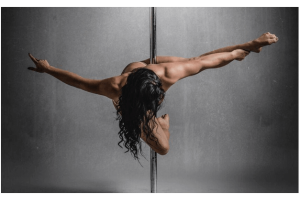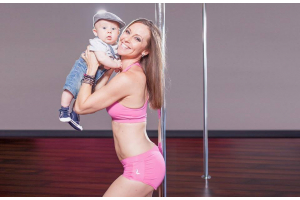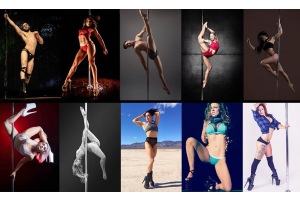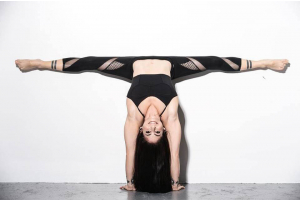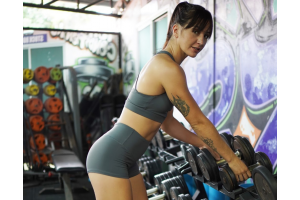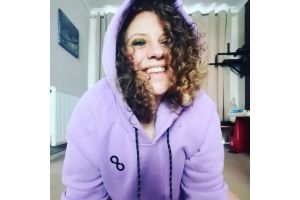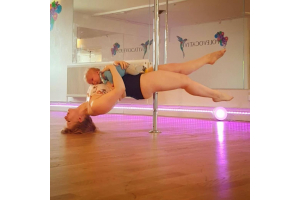Aisling Peberdy | Breaking records without breaking yourself | Episode #004
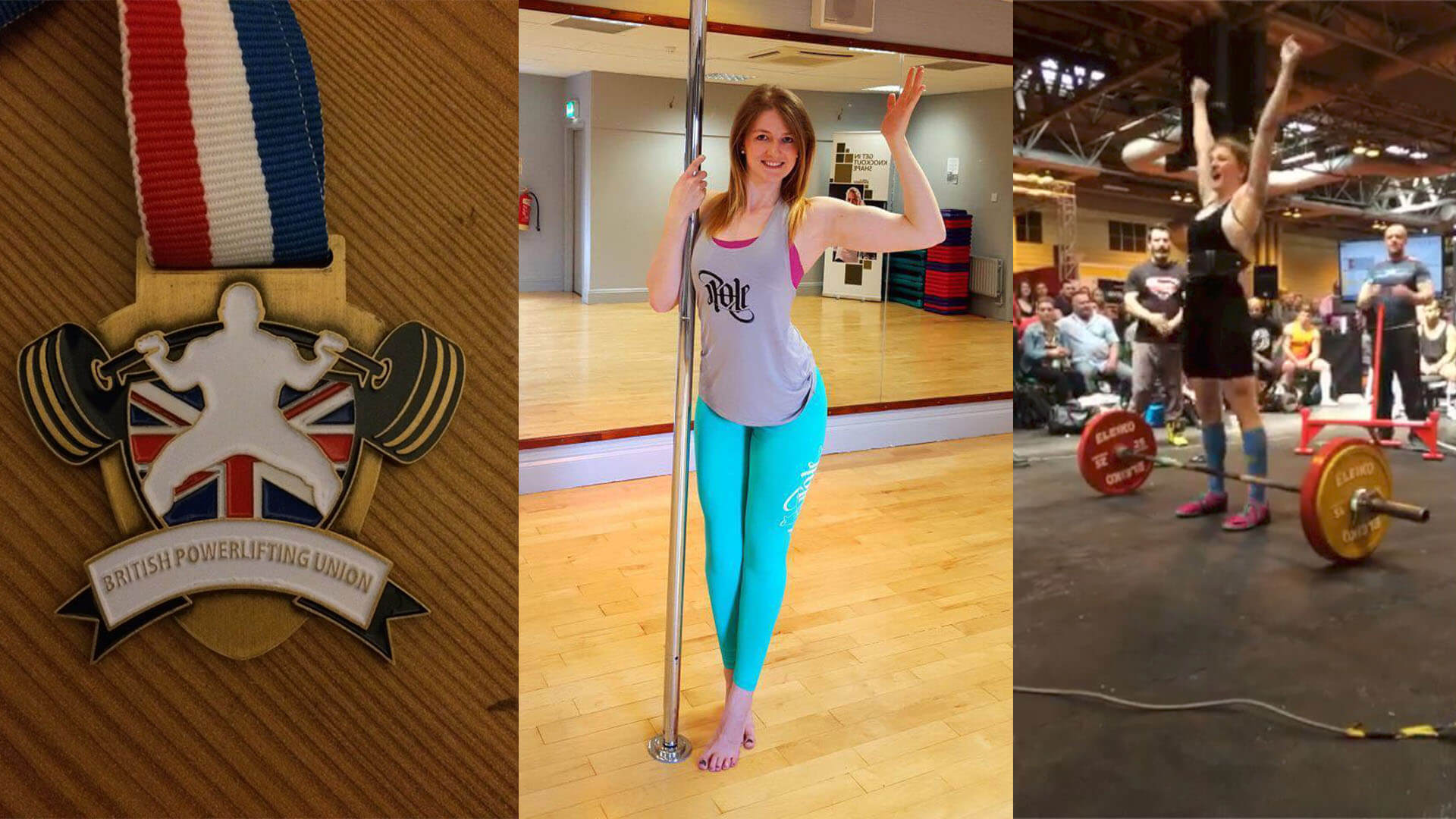
Episode #004 of the Off The Pole Podcast is a Group Member Feature - I hope to do many more of these as we have such a talented bunch in there! I got to sit down to chat with Aisling Peberdy, who's been Pole Dancing for 6 years. She's an Osteopath, qualified in clinical nutrition as well as being a champion powerlifter. If you love getting geeky about anatomy, you're going to love this!
Really hope you guys enjoy the 4th episode in the podcast series - you can subscribe to our pole podcast on iTunes to keep updated with all the latest episodes and it would mean the world to me if you could leave a review!
Hit play above or read the transcript below.
Sarah: Well, welcome Aisling, thank you very much for doing my podcast, it's lovely to have you.
Aisling: That's okay, nice to be here.
Sarah: So for the people who don't know you, can you give us just a little bit of an introduction. Tell us about yourself, your background, how you came to pole?
Aisling: Sure, so yeah I'm Aisling and I'm an osteopath and I've been in private practice since July 2016, after completing a four-year masters degree. I came to pole six years ago, yeah six years ago when my mum, there was a class at my mum's gym and she said, "Do you want to try?" I said, "Yeah okay." So yeah; ...
Sarah: Your mum got you into it? That's awesome.
Aisling: My mum, she's only had a go like twice, but yeah she's like, "Do you want to do this?" So I did, and yeah I did regular classes for my final year of A-levels and then it was more kind of an ad-hoc basis, and then properly got back into classes in December, with Dan.
Sarah: Oh nice.
Aisling: Lovely Dan, hi Dan.
Sarah: Mr Rosen, yeah we love Mr Rosen, shout out to Dan.
Aisling: And everyone at IFA who I miss 'cause I haven't been for like a month now.
Sarah: You're going to get in trouble now, you're going to get called out for representing pole and not going to pole class.
Aisling: I'm going to be in trouble.
Sarah: Sorry we won't tell, it's fine.
Aisling: So yeah that's it.
Sarah: When we started chatting you sent me a message after I posted in Facebook group Off The Pole, so you're obviously a member of that 'cause you saw it, hopefully...
Aisling: I am.
Sarah: You also said you're into powerlifting as well, is that right?
Aisling: Yeah, so I started powerlifting when I was at uni, and somebody in the year above me was powerlifting, a guy, ended up going to train with him a little bit. Originally I started lifting to help with pole actually and my PT at the time was like, "Oh you're quite strong, you know let's see how far we can push this." Yeah, got chatting to this chap at uni, started training properly and entered my first competition, December 2014, and won, and then when onto ... which is a cash competition and there aren't very many of them, so that was also quite nice, 'cause being a student I needed to pay my rent. Then went to qualifiers, qualified for the British Nationals and in July 2015 I became British Champion, which is always quite nice.
Sarah: Nice!
Aisling: Then last year was my last, my most recent competition, and now that's a lie, two years ago, oh God that's bad isn't it. Two years ago was my last proper competition and that was at Body Power just doing a deadlift only and I set a still-unbroken record for deadlifting, so that's kind of nice.
Sarah: Pole dancers represent!
Aisling: Exactly, and it was a lot of it was like, I kind of when I tell people, especially my patients, they're just like, "Oh but we never would have thought that you lift, because you're not bulky, and you're really slim." I was like, "Well, woman don't get big like men get big. We don't have the right hormones. You'll get strong, your shape will improve, you'll just be so much more confident." It's a pretty good feeling when you walk into a gym and you warm up with whatever the guy was lifting as his working set, that's quite nice.
Sarah: Definitely
Aisling: So yeah, I really, and in my private practice as well I really promote weight lifting for women, just for everything really.
Sarah: Do you feel like you, like how do you balance out your pole training and your powerlifting? Like do you have a set structure you do during the week? Or do you find that you tend to go more towards one if you've got a competition coming up?
Aisling: Yeah so when I'm competing, powerlifting wise, pole training kind of takes a bit of a back set about a month before I compete. The biggest challenge is as soon as I get ready for a comp, or as soon as my lifts are really increasing in numbers, when I'm coming to like a peak week, or a really heavy week, my flexibility just goes totally rubbish. I mean it's not great to start with, and so I have to really work at being flexible. But when I'm really lifting, and you need that stability within the muscles, you need that bracing, I can't then go and work on my flexibility because my lift will significantly come down. Just 'cause you don't have quite enough stability within the muscles. It can slightly bring your strength down, very slightly but for a competition that could be the difference between gold and silver.
Sarah: Yeah, you're working at an elite level so...
Aisling: Then I've not done a pole competition so, if I did, if I ever did I can imagine powerlifting would take a bit of a back seat because I wouldn't be in the best condition, and I wouldn't be very flexible basically. So the main problem for me is balancing flexibility and stability as we do.
Sarah: I think we struggle enough with that in pole as well, it's like how you split your training between conditioning and learning new tricks, and then flexibility training and floor work, and choreography. There's so many pieces just for pole, and then to add in like another discipline on top of that especially at such a high level it must be difficult to find the balance. But you've obviously done extremely well to already had that kind of foundation strength from pole dancing, a lot of bodywork stuff, and then you've managed to kind of layer on the weight lifting on top of that.
Aisling: Yeah absolutely, and I think the fact that I'm not at an elite level in pole kind of helps me a bit, if I was trying to do both at the same time that would be more challenging. I'm sure there's other people that do kind of two really high kind of levels at the same time, and that's ... in pole it's a really kind of gymnastic, flowy kind of a thing and powerlifting really, really isn't. So two ends of the spectrum, which is nice, 'cause it's nice to have completely different things to work to.
Sarah: Yeah, I would agree with that too. So you do, you're an osteopath, and you've been doing that since 2016. Do you find you've had an influx of pole dancers coming to you? Or do you stay away from pole dancers 'cause you know what we're like!
Aisling: So that's an interesting one, so in my first clinic, so I was self-employed initially, and I worked in somebody else's clinic and I had one clinic that were basically didn't want anyone to know that I did pole. So it was really quite tough for me and I just thought, oh my goodness me, I've just gone back about 20 years or something. It was quite tricky because I think poles a great exercise, and I don't care who knows that I do it. They said, "Oh no, it's not professional." Which was quite annoying because we're not in like 19th century anymore. My other clinic were fairly open about it and since I've started representing the Back and Body clinic in Northampton - I'm really lucky, so at the clinic I'm in now, they really love all kind of the pole stuff and they're like, "Oh that's awesome." Actually, we're kind of doing a big workshop all together, and I'm going to get the whole clinic involved in pole dancing. In terms of kind of patients that are pole dancers, I've had a couple kind of, that I treat privately. But I don't tend to get many of them into my clinic, in fact I think I've had a couple, who do it, or have done it before a couple of times, and they're like, "Oh no, but you have to be really strong." I said, "Yeah but it builds up."
Sarah: Yeah, that's the point of going, getting easier!
Aisling: The majority of people are like, "Oh yeah I think I'd really like to give that a go." Yeah so I've had a few.
Sarah: Are there common issues that you come across? Like is there any kind of stand out things that you're like, "Ah you're a pole dancer, you have this issue."?
Aisling: So shoulders, we love our shoulders...Shoulders are great because they're really mobile and we sacrifice stability of the shoulders so we can have that mobility. Which is obviously really useful in putting our clothes on for example, or just general day to day activities. But because it's less stable, kind of the structure, the capsule that holds the shoulder together, you can actually see it when you look at a dissected body, you can see; ...
Sarah: Oh I do that all the time, yeah, just next time I see one I'll be sure to look out for it yeah...I'm joking.
Aisling: You can actually see kind of the front part of the shoulder is visibly a bit saggy, compared to the back. So things like dislocations will often happen, it comes forward and down, so your humerus, your arm bone, comes forward and down and that's ... I mean I haven't seen any of those myself but it's quite a common one, either a dislocation or partial dislocation in pole, also in gymnastics sports as well. So obviously preventable to a degree, with a certain amount of conditioning, but not always completely preventable, unfortunately, these things do happen.
Sarah: Yeah do you get pounced in your class when people have got shoulder problems and they know what you do, so they'll, "Quick take a look at my shoulder and diagnose me."
Aisling: We have been asked a few times.
Sarah: You're like, "Come to my clinic."
Aisling: Yeah, have wrists as well, because obviously, we put quite a lot of strain to our wrists, and wrists are quite a vulnerable area and also a bugger to treat so please don't damage them. But yeah shoulders, so not just kind of dislocations, but rotator cuff tears and labrum tears. I'll into these in a second, but ... so if we think about how unstable, how mobile the shoulder is because of that ligament capsule is pretty weak, there's got to be like a second sort of line of defence in terms of its stability and that is our rotator cuff.
So they kind of wrap around nicely giving a little bit of a cuddle to your shoulder effectively. We do in pole, we abuse our shoulders a little bit and we put the tendons under strain. One of the most common ways of straining our tendons are things like handsprings, especially twisty grip but that's kind of a slightly different, we'll go into that one in a second. But anything where we're basically putting the whole weight of our body through our shoulder. You can get a traction injury, so if the humerous coming along, basically you're making the joint a little bit bigger than it is, and you're putting a lot of strain through not only the rotator cuff but also then the ligaments and then also this little thing called the labrum. Which is this bit of cartilage on the socket part of the ball and socket joint. When that happens, when you kind of traction it away, you get a tear through there, and they're not so great. You do need surgery for them, but thankfully they're pretty rare in terms of pole injuries.
Again it's all about being sensible and not doing too much too soon. When it comes to twisty grip, you're putting that shoulder right into this internally rotated position, and when it's there one specific tendon, your supraspinatus tendon, so it comes across the top of your shoulder blade, and it goes through a little tunnel, and through that tunnel and it attaches onto the back of the humorous, so our arm bone again. Now when we internally rotate the shoulder, you really close down that tunnel, so it's not much space anyway inside the tunnel, but then you close it down even more and then you ask the muscles to kind of start working and to lift you up and do all sorts of things, and then to stabilise you. At that point, it's like, I'm not a miracle worker.
Sarah: It's had enough!
Aisling: It's cross with you at this point. So best case scenario it becomes a bit inflamed and you get tendonitis and worst case is it completely rips. But haven't seen one yet, but again if we can condition our bodies before doing twisty grip, if we can do cup grip, true grip, it's such a more biomechanically advantageous position to put our body in, to put our shoulders in, to preserve the life of our shoulder and the life of our pole dance career.
Sarah: Yes I would, I think there's many instructors like shouting, "Hallelujah" down the phone at you for sure. I think the issue comes when it feels easier so people think because they're locking the joint out, they can then hang on that joint but, just yeah as you say taking the time to condition, do the other grips first is going to pay off so much more in the long run. In fact, you don't need the twisty grip anything like as much as you think you do, it's a great transition but it's not, it shouldn't really be seen as a strength move and I think, it's moving more towards that now in the pole industry that's good.
Aisling: Absolutely.
Sarah: I think as more people are being more vocal about the shoulder surgeries they are getting and people are realising that it isn't necessarily just, it's not just easier, it's potentially a lot more dangerous. It's nice to like get the breakdown of the anatomy, visually I think when you start learning about the shoulder it freaks you out enough to start looking after it. I was like, "Oh that's what in there."
Aisling: "That's what's happening, oh God!"
Sarah: For sure.
Ashleigh: Yeah and like obviously when you're doing other grips you're actively contracting those muscles, so you're doing active stability, whereas when your kind of like this, nothing can contract properly so you're really relying on the passive stability of the tendon, of going through that little tunnel. Then also of all those really weak ligaments, and when you think about you're like, "What am I doing that for? Why am I trusting my whole body in this kind of crappy not very strong shoulder."
Sarah: Yeah, I suppose that kind of leads me on to my next little point of like, what areas of training do you think that pole dancers don't necessarily spend enough time on it? What could they be improving so that they could be reinforcing all the points that you've been saying?
Aisling: So we really, really need to do functional and relatable conditioning exercises. So if you start, as much as I love overhead pressing, you're not really going to be able to translate that directly onto a pole. So I love things like pull ups, pull ups I love because you're using that grip element, which is also kind of important for what we do. Anything that involves a wall bar, for kind of the same reason because you've got to really lock in the shoulders. Let's say you're doing just leg raises off the wall bar, but if you're holding onto the wall bar and you just gently kind of pull your shoulder down, just so you can feel it contracting, and then do your leg raises from there. You're improving the stability of the shoulder under load, coming from your legs and also helping with your abdominal strength.
What else? So I really love anything that involves a single arm exercise. So obviously being in the gym quite a lot, single arm dumbbell presses, literally kind of sitting but also being really aware of contracting the shoulder and really nice and slowly controlled, not kind of going for 100 reps as quickly as you can, but really feeling and focusing on the stability within the shoulder. Really slowly lowering it down, it's that slow lowering in the centric phase that's going to really help with the tendon strength itself. Tendons love to be loaded basically, so this centric phase is so important.
Things like that to support the rotator cuff, and to kind of support the stability of the shoulder from a neurological point of view as well. So your kind of training these motor patterns, so your body and your brains like, "Yeah we've done this before, I know, which muscle to switch on when I'm gripping and when I'm doing x, y or z." Then it just becomes second nature to your body. So the kind of neural training is as important as the muscular training.
Sarah: Yeah and sometimes it the smaller things that actually, they might be not be as fun for our training 'cause we're used to like mucking around and flying around a pole, but if you want kind of I guess that's what I've been trying to promote with the Off The Pole group. Is that, if we can train a little bit of things that we need to do, then we can train what we want to do for longer. Because we all want to pole dance, that's why we go into pole dancing.
Aisling: That's why we do it.
Sarah: Because it's fun, we don't necessarily want to be at the gym all the time. But some of these exercises can be massively beneficial for stabilising it, and then pole gets better and then you can pole more, you're not relying on the wrong muscles and tendons.
Aisling: Absolutely, yeah so a lot more shoulder stuff, but also something that I think that can be easily neglected is the glutes. Now loads of people are really good at training their glutes but from what I see in the majority we just kind of forget about it in pole, we think, "Well what's my bum got to do with anything." Basically, that could be a quote.
Sarah: Looking good in hot pants?
Aisling: Well exactly!
Sarah: We try...
Aisling: Yeah for good Sunday bum day pictures! So when we talk, and this kind of leads me onto like the core and things. So in the 1990's one guy wrote one paper on core stability, which was based on not very good research and all of a sudden the fitness industry picked little bits from it and it kind of ... It was like right, everyone's got to do this, and so did kind of the rehabilitation industry as well, they were like, "Yeah this is amazing and it's going to do all these magical things and nobody will ever need treatment ever again if they do three things, three times a day." But unfortunately kind of over time people have taken the core, so it can be really misinterpreted quite a lot of the time, and "I'm going to train my core today" and I said, "Right, what do you mean by that?"
Sarah: "Crunches"
Aisling: Yeah, "I'm going to do some crunches." I thought, "Oh God." Like first of all; ...
Sarah: Well that's kind of what we have been told, the fitness industry does say you know, lots of core exercises, ab exercises, it's all about kind of the 'six-pack' why wouldn't we necessarily think anything else?
Aisling: Yeah, exactly, so crunches is like my worst nightmare first of all because the majority of people just doing like a normal crunch on the floor, they're going to use their hip flexes more than their abs anyway. Actually you're going to decrease the strength of your abs and probably injure your back in the process. But there's lots of other things that you can really focus on for oblique strength and for ab strength. But when we talk about the core, lots of people think, "That's my abs." And you think, "No, no, it's so much more than that." The core in itself is all the trunk muscles together, so all the muscles of your back, all the muscles in your tummy, and your glutes as well. Everyone kind of forgets about the glutes generally. So it's just like, "Well let's start doing," I'll say, "Okay so you want to train your core? This is what you're going to do." But these are hip thrusts, these are glute bridges, these are squats, how's this going to help, and I said, "Well actually" ; ...
Sarah: "I'm magic and you'll see!"
Aisling: Yeah, so much better, no, if you think about it, it's just on your pelvis, if you think about your whole kind of trunk, why wouldn't you include your glutes? Why would you leave them out? They're such a good, often forgotten muscle, when we, the majority of people work at desks nowadays have really, really weak glutes, just 'cause you don't use them. That has been linked to things like lower back pain, and in some case's disc prolapses, not to scare anyone. Disc prolapses happen a lot by the way, very, very common. You've probably got one without knowing. It's a very common thing.
Sarah: Go see an osteo, get yourself checked out, yeah?
Aisling: But just because you have a disc prolapse doesn't mean you won't ever be able to do nothing again. They're so common, we see them all the time. Yeah, you might have one and not know about it, which is also fine by the way. But yeah so I think glutes training is something that we need to improve on as a whole community, like in classes we should have, when we do continuing, a bit on glutes whether it just be glute bridges, low range squats, so you're actually targeting the glutes not just your quads. Dead lifts, doesn't have to be like a dead lift with a massive barbell. You can do a dead lift with a dumbbell, you can do a dead lift unweighted. What other sorts of things? Split squats, I love split squats, Bulgarian split squats they're awesome and they leave you with like a really, really good pump as well, which is quite nice.
Speaker 2: That's where the hot pants come in.
Aisling: Exactly, and like; ...
Speaker 2: You've got to drop that into people, otherwise they won't do them.
Aisling: It will make your bum look good in hot pants.
Speaker 2: There we go.
Ashleigh: Amazing. Have you heard of Brett Contreras?
Speaker 2: No, I haven't.
Aisling: Okay you need to look him up, he is literally he's made his business on glute training. He is the glute guy.
Speaker 2: He sounds like my kind of guy.
Aisling: He's awesome.
Speaker 2: I like him already.
Aisling: He's amazing and he has a PhD so he's a properly researched scientist who has put his research into getting you a better bum for hot pants, basically. I highly recommend everyone goes and follows him. He's wicked. But there's a really cool move called the Froggy Pump, so that's your homework.
Sarah: Okay. We will try and find a link to that and put it in the links below, yeah. We will have a look at that, that sounds very intriguing.
Aisling: It is.
Sarah: I'm definitely a big fan of glute training, I think it's massively overlooked, I do a lot of glute bridges, hip bridges and things like that in my training. A lot of the time it's also, I actually did a PoleWOD it will be released by the time this comes out. It's all about fixing the anterior pelvic tilt and kind of strengthening like, squeezing the glutes, getting those switched on, stretching out the hip flexes and strengthening that position, because we all tend to arch our back and stick our booty out and we're sat down all the time our hip flexes are getting shorter, tighter. We go to pole and do those leg lifts and only make it worse so, yeah just having a little bit of time to undo those and balance out your training can be so beneficial plus make your bum look good. I mean this is the best, this is a good tag line.
Aisling: Absolutely, yeah, but I definitely agree. Yeah like if anyone panicking about core, so you hear the words core stability a lot and actually there's not a huge amount of research behind it. For pole dancers we need to work on core strength, but people go on, "Oh core stability, I've got to do this or I'll get back pain." That's rubbish just to let you all know. It's been completely disproven, but that's kind of my own issue with the buzz words of core stability, core strength yes, remember your glutes. Core stability...
Sarah: She's (Aisling) making a cross.
Aisling: Just no, just no.
Sarah: No core stability, okay.
Aisling: I link you to a really good paper if anyone's interested.
Sarah: We'd love that yeah. We collectively, I speak for everyone. Yeah definitely we will post that in the Off The Pole group.
Aisling: We'll all be academics.
Sarah: Yeah, well I think it's nice to know, the more you know about your body, even though you do feel like you might learn at school, or you might do it for a job now, learning a little bit about anatomy can be hugely beneficial for your own training. Just helps with your body awareness, helps with if somethings not working, or not necessarily feeling that right. Not that you should be diagnosing yourself, but I know that if I've got lower back pain, I can at least try and roll out my piriformis, stretch out my hip flexes, at least start to try and find what I can release before I then go see a sport's therapist, or an osteo.
Aisling: Absolutely.
Sarah: That's just once you know what the muscles do, you can be like, "Well I was doing a lot of this yesterday so that's why that's tight."
Aisling: "Maybe I've done this", yeah.
Sarah Yeah, normally I'm just sat in a car training, and then sat in a car and then training or teaching for long periods of time then I get super tight.
Ashleigh: Yeah, no, I think education is so important and we put our bodies through a lot so kind of knowing what we're doing is always kind of a good idea. I think, I know a lot of the instructor courses obviously you do cover anatomy and physiology to a degree, which is absolutely brilliant now. Because I know at one point it just didn't happen.
Sarah: "This is a pole trick, just get on with it you'll be fine!"
Aisling: Yeah, and yeah I'm really pleased. But I think, yeah I am pleased. I'm really pleased that people know more about anatomy and I think we could all do with learning a bit more anatomy.
Sarah: Yeah, we're helping to spread the word.
Aisling: It's quite fun.
Sarah: Well that seems to be a good time to wrap it up on that nice little kind of positive note. Really, really appreciate you coming on and sharing all of your awesome knowledge. I'm sure that you're going to get pounced on in the group for lots of advice now, but yeah thanks very much for coming in and we'll maybe get you back again.
Aisling: Thank you for having me. Thanks very much, I hope it was helpful?
Sarah: Super, super helpful!

